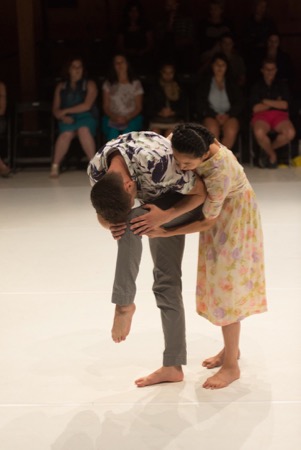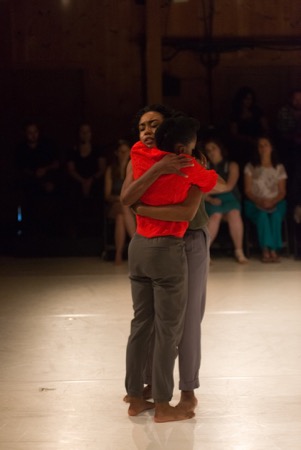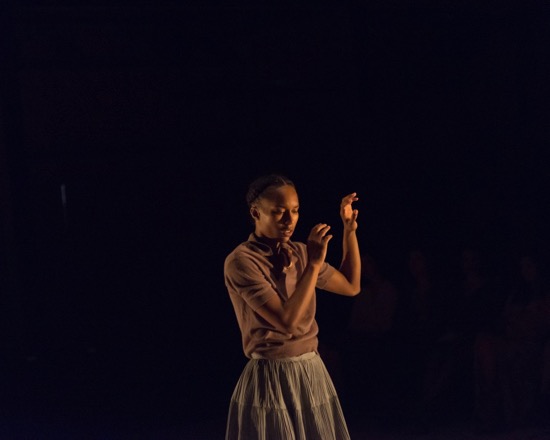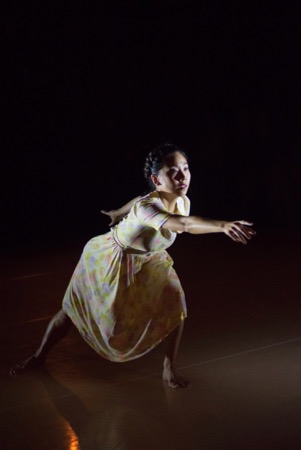Kyle Abraham/Abraham.In.Motion at Jacob’s Pillow, August 2 through 6

Jeremy “Jae” Neal (L) and Tamisha Guy in Kyle Abraham’s Dearest Home. Photo: Brooke Trisolini
Kyle Abraham has always treated his own life and times as soil on which to build dances: his family, the Pittsburgh he grew up in, racism, gender bias, politics. Hip-hop introduced him to dancing; ballet, modern, and postmodern styles followed. Film and text clarified ideas. Yet his works have never seemed didactic—partly because of how skillfully he structures them, but also because of his movement style. As I wrote of his Absent Matter in 2015, “The people onstage approach the complex, dynamically inflected movement as if it were a metaphor for living, not a substitute for words.”
That is true too of his latest, more pared-down work, Dearest Home, which I saw his company, Abraham.In.Motion, perform in the Jacob’s Pillow Dance Festival. This beautiful piece isn’t twined around specific events or credos, and although three words— love, longing, and loss—impel it, we never hear them spoken. In fact, we may hear nothing but the sound of breathing, a foot brushing the floor, or a stray cough in the audience. The dance was composed and rehearsed in silence; spectators in the Doris Duke Theatre can experience it that way or listen to the score composed by Jerome Begin via handed-out earphones. (I never heard the music, because my earphones weren’t working properly).
The audience, seated on all four sides of the high-ceilinged barn theater, takes in Dearest Home at close range. No wings hide the wooden walls. No lights sit at our feet. Dan Scully’s wonderfully expressive lighting beams down from on high and can also illumine the walls from behind the banks of spectators. The six performers enter and leave this arena via its four corners. Perhaps “arena” is a misleading word, but what else is a home? Not an arena for prizefights, but a place in which we discover and perform rituals, learn things, explore relationships, and express feelings.

Connie Shiau aids Matthew Baker in Dearest Home. Photo: Brooke Trisolini
The marvelous performers—Matthew Baker, Tamisha Guy, Catherine Ellis Kirk, Marcella Lewis, Jeremy “Jae” Neal, and Connie Shiau—come from divers backgrounds and places and work together with uncommon grace and understanding. The fact that they are performing in silence makes them especially watchful of one another, especially when they dance in unison. One person, feeling good, may smile; her/his partner responds. One person may look at his/her own trembling hands; the partner of the moment walks away.
All six performers are never on view at the same time (you can imagine them spending time in other rooms or maybe in a backyard). We meet them in solos, duets, and a trio, all of which happen without fanfare. Partners or friends or family members, they want to love one another always, but maybe at times do not, cannot. Any of us know what it means to comfort someone one in need on Monday and shove that same person away in a Tuesday argument.
The action often happens very close to us. We see these people’s smallest nuances of behavior, we hear when they’re out of breath. We wonder about them. What kind of ritual is temporarily aborted when Baker carefully removes his trousers, the Hawaiian shirt that he has had trouble keeping tucked in, and a white tank top, all of which he carefully folds and carries away? Why does Lewis suddenly push Neal out one of the exits. I don’t mind not knowing the answers.

Marcella Lewis (facing the camera) embraces Tamish Guy in Kyle Abraham’s Dearest Home. Photo: Brooke Trisolini
We can notice motifs: a dancer makes a gesture that looks like reaching out to gather in air and then runs close-together hands down in front of his/her body. A tight hug appears in every duet. From time to time, worry or grief besets a performer, and, unsettlingly, we hear a smothered sob (once, Baker has trouble controlling an urge to break down). Lewis, alone in the space, cramps over, her arms tightly hugging her belly. Two people hold hands and dance conjoined for a while. They may also take hands briefly and let the impulse slide away.
The choreography has its own characteristics. A smooth, slow passage may be interrupted by explosive moves, then calm down. Big, sweeping steps contrast with small gestures, polished dancing with easy-going walking, tentativeness with assurance. Unlike much of what we see onstage these days, Abraham’s choreography has the kind of expressiveness that infuses good conversation. The dancers may silently drawl or sputter or sing out movements, or ration them via hesitation. Champions at body linguistics, they’re able to summon up fluid ripples of motion or bring one set of muscles into negotiations with another set. You watch them and ponder what they’re thinking, what they’re feeling.

Catherine Ellis Kirk in Dearest Home. Photo: Brooke Trisolini
In these close quarters, the lighting affects us more than it would in most theaters. A sudden glare includes us. We lean forward to peer into near darkness. When the atmosphere warms up with a touch of color, we relax a little. During a moment when Baker is alone in the area, rays of light make him the center of his own shadow, quadrupled on the floor around him. The costumes (clothing selected by the choreographer) also influence how we see the dancers. Shiau, fiercely strong though she is, wears a short summer dress with a faded pattern that emphasizes her long, slender limbs as they reach and flail, and aids her in seeming vulnerable. Guy, wearing pants and a tight orange top, her hair in a neat twist, cuts the air precisely with her arms and legs. It’s a surprise when she’s suddenly curled up in Lewis’s arms; most of the time, she’s in charge of what she’s doing. And is it only because Kirk is the tallest that we see her as more mature, or is it the scooping, folding gestures and the slow, ground-covering calmness of her solo?
The one time that three of these open-hearted people connect made me wish for more such encounters. For a while, Shiau and Baker support Neal between them—close to him, letting his arms hang over their shoulders, but other negotiations are more complex, changing so quickly that you can’t decipher them. If one member of the trio moves briefly away, the other two embrace, but then pull the third back into their cluster. The contacts aren’t all comfortable; Shiau grabs Neal’s hair to pull his bent head up. Sometimes none of them seems to know where to place a hand.

Connie Shiau in Kyle Abraham’s Dearest Home. Photo: Brooke Trisolini
In Abraham’s tender world, changes of clothing may signify changes in the time of day, the room, or the performers’ feelings. Neal removes his shirt. Lewis and Kirk strip to their underwear for a duet and casually sling the discarded garments toward spectators’ feet. The final image, however, is anything but casual. The theater gets so dark that we can barely see who there. It’s Neal. Solitary, naked, hunched over, moving slowly, he is pouring himself into that suddenly shrinking space. Ironically and movingly, we, the multitude of watchers, share his aloneness.
